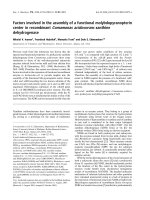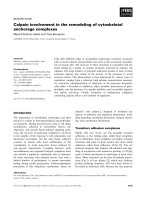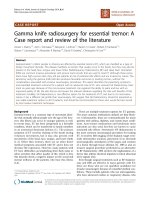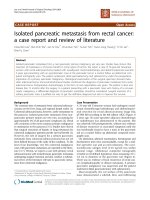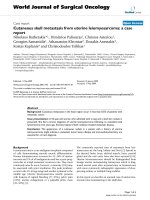báo cáo khoa học: " Aggressive angiomyxoma in the inguinal region: a case report" potx
Bạn đang xem bản rút gọn của tài liệu. Xem và tải ngay bản đầy đủ của tài liệu tại đây (414.41 KB, 3 trang )
CAS E REP O R T Open Access
Aggressive angiomyxoma in the inguinal
region: a case report
Takeshi Kondo
Abstract
Introduction: Aggressive angiomyxoma is a rare myxoid mesenchymal tumor of the pelvis and perineum, which
occurs almost exclusively in adult women. The tumor is especially rare in men.
Case presentation: We report the case of a 68-year-old Japanese man with a slowly growing inguinal swelling. At
surgery, a huge mass in the soft tissue of the inguinal region was found, not involving the adjacent organs. The
morphologic picture was compatible with aggressive angiomyxoma of the inguinal region.
Conclusions: Aggressive angiomyxoma is a very rare, locally infiltrative neoplasm. Thus, after surgery, close
follow-up is needed because of a high risk of local recurrence.
Introduction
Aggressive angiomyxoma is a rare mesenchymal tumor
of the pelvis and perineum that occurs almost exclu-
sively in adult women [1]. It preferentially arises from
the soft tissue of the pelvic region, perineum, and geni-
tal area. Its incidence is approximately sixfold higher in
women, and 24 male cases have been reported in the lit-
erature [1]. The tumor is usually locally infiltrative and
has a high rate of local recurrence after surgical excision
[1]. The adjective “aggressive” emphasizes the neoplastic
character of the blood vessels, its l ocally infi ltrative nat-
ure, and th e high risk of local recurrence, not i ndicating
a malignant potential of the lesion. Rarely, this tumor
appears in men, simulating inguinal hernia, testicular
neoplasm , spermatic cord neoplasm, hydrocele, or sper-
matocele [2,3].
Case presentation
A 68-year-old healthy Japanese man presented with a
slowly growing swelling of the soft tissue in the inguinal
region (Figure 1). The durat ion of symptoms was about
five years. At surgery, a large encapsulated mass
(7.5 cm) was found, not involving the adjacent structure.
The tumor was easily removed, as it was discrete and
without adhesions. The cut surface of the tumor was
smooth, homogeneous, and gray-white (Fig ure 2a). His-
tologically, it was a paucicellular (hypocellular) tumor
composed of fibrotic and myxoid areas, showing a
sparse populat ion of spindle-shaped tumor cells without
significant cytologic atypia or mitosis (Figure 2b). Foci
of thick-walled blood vessels of various sizes were iden-
tified. The tumor cells were positive for CD34, and
negative for a-smooth muscle actin and desmin. The
tumor cells were negative for hormone receptors (ER
and PgR). Chronic inflammatory cells were found scat-
tered in the stroma. The morphologic picture and the
immunostain were compatible with aggressive angio-
myxoma in the inguinal region. The operation itself was
uneventful and, on follow-up, no signs of recurrence
have appeared for about one year.
Discussion
Since 1983, when aggressive angiomyxoma was first
described by Steeper et al., about 100 cases in both sexes
(including 24 men) were reported worldwide [1]. It often
occurs in middle-aged patients (mean age, 46 years) [1].
Occurrence of aggressive angiomyxoma in men is extre-
mely rare, and, in men, aggressive angiomyxo ma is
usually derived from the pelviperineal interstitial tissue
involving the scrotum (38%), spermatic cord (33%), peri-
neal region (13%), and intrapelvic organs (8%) [1].
Macroscopically, its typical cut-surface appearance is a
large, grossly gelatinous, and locally infiltrative tumor.
Microscopically, the stroma is rich in collagen fibers
Correspondence:
Division of Legal Medicine, Department of Community Medicine and Social
Healthcare Science, Kobe University Graduate School of Medicine, 7-5-1
Kusunoki-cho, Chuo-ku, Kobe 650-0017, Japan
Kondo Journal of Medical Case Reports 2010, 4:396
/>JOURNAL OF MEDICAL
CASE REPORTS
© 2010 Kondo; licensee BioMe d Central Ltd. This is an Open Access article distributed under the terms of the Creati ve Commons
Attribution License ( s/by/2.0), which permits unrestricted use, distribution, and reproduction in
any medium, p rovided the original w ork is properly cited.
with a prominent vascular component, including many
thick-walled vessels. The differential diagnosis includes
angiomyoblastoma, myxoid neurofibroma, myxoma,
spindle cell lipoma, and myxoid liposarcoma [1,2].
Immunohistochemically, the stromal cells of the tumor
show strong positivity for vimentin and variable positiv-
ity for desmin, a-smooth muscle actin, and CD34 [2,4].
Immunohistochemical studies have revealed that
tumor cells are immunoreactive for no specific marker.
Male angiomyxoma may be positive for estrogen and
progesterone receptor [2]. The tumor cells in this case,
however, were negative for the two markers.
Cytogenic analysis reveals chromosomal translocation
involving chromosomes 8 and 12, associated with rear-
rangement of the HMGIC gene [1].
Surgery is the principal first-line treatment to date and,
because of the high risk of local recurrence, a long-term
postoperative follow-up with either ultrasound (US) or
computed tomography (CT) is recommended [1]. The
recurrence may be attributed to incomplete tumor resec-
tion, because of the infiltrating nature, and the absence
of a definite capsule. The earliest recurrence has been
reported as appearing nine months after surgery [5]. No
distant metastasis, however, has been reported.
Conclusions
In conclusion, aggressive angiomyxoma is a very rare
neoplasm that is more predominant in women. After
surgery, close follow-up is needed because of the high
risk of local recurrence.
Consent
Written informed consent was obtained from the patient
for publication of this case report and accompanying
images. A copy of the written consent is available for
review by the Editor-in-Chief of this journal.
Acknowledgements
I thank Nao Yoshida, Mika Ohya, and Yuko Nishikawa at Shinko Hospital, and
Michiko Tajiri-Mori and Shuichi Matsuda at Kobe University for their excellent
technical assistance. I also thank Dr. Takahiro Tokiyoshi at Shinko Hospital for
providing clinical images.
Authors’ contributions
TK performed histologic examination, analyzed the case, and wrote the
manuscript.
B
A
Figure 1 A slowly growing swelling of the soft tissue in the
inguinal region. (a) Swelling of the soft tissue in the right inguinal
region was observed. (b) Magnetic resonance imaging revealed that
the lesion (arrows) was isointense relative to muscle on the T
1
-
weighted image.
B
A
Figure 2 Mac roscopic and microscopic findings of t he lesion.
(a) Macroscopic finding of the tumor. The tumor measured 7.5 cm
and had a relatively clear margin. The cut surface of the tumor was
smooth, homogeneous, and gray-white without necrosis or
hemorrhage. (b) Microscopic findings of the lesion (hematoxylin
and eosin stain, ×200). The tumor was composed of spindle cells
and blood vessels with myxoid stroma.
Kondo Journal of Medical Case Reports 2010, 4:396
/>Page 2 of 3
Competing interests
The authors declare that they have no competing interests.
Received: 12 April 2010 Accepted: 8 December 2010
Published: 8 December 2010
References
1. Morag R, Fridman E, Mor Y: Aggressive angiomyxoma of the scrotum
mimicking huge hydrocele: a case report and literature review. J Case
Rep Med 2009, 15:7624.
2. Idrees MT, Hoch BL, Wang BY, Unger PD: Aggressive angiomyxoma of
male genital region: report of 4 cases with immunohistochemical
evaluation including hormone receptor status. Ann Diagn Pathol 2006,
10:197-204.
3. Tsang WY, Chan JK, Lee KC, Fisher C, Fletcher CD: aggressive
angiomyxoma: a report of four cases occurring in men. Am J Surg Pathol
1992, 16:1059-1065.
4. Iezzoni JC, Fechner RE, Wong LS, Rosai J: Aggressive angiomyxoma in
males: a report of four cases. Am J Clin Pathol 1995, 104:391-396.
5. Chuang FP, Wu ST, Lee SS, Chen HI, Chang SY, Yu DS, Sun GH: Aggressive
angiomyxoma of the scrotum. Arch Androl 2002, 48:101-106.
doi:10.1186/1752-1947-4-396
Cite this article as: Kondo: Aggressive angiomyxoma in the inguinal
region: a case report. Journal of Medical Case Reports 2010 4:396.
Submit your next manuscript to BioMed Central
and take full advantage of:
• Convenient online submission
• Thorough peer review
• No space constraints or color figure charges
• Immediate publication on acceptance
• Inclusion in PubMed, CAS, Scopus and Google Scholar
• Research which is freely available for redistribution
Submit your manuscript at
www.biomedcentral.com/submit
Kondo Journal of Medical Case Reports 2010, 4:396
/>Page 3 of 3
